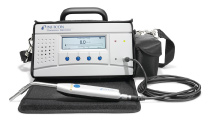World War II Mustard Gas Munitions Destroyed in Leak-Tested Chamber
Almost 70 years after the end of World War II, there still remain significant quantities of dumped mustard gas in the seas around Sweden. In fact, the Baltic Sea may have the highest concentration of chemical warfare agents of any sea in the world. Mustard gas shells are a major hazard for both fishermen and the public using the sea for leisure activities.
Dynasafe specializes in the production of equipment used to destroy various types of shells and other explosive objects. The shells are destroyed in Dynasafe's detonation chamber and the leftover materials are recycled. Dynasafe has delivered equipment for destruction of mustard gas munitions to the USA, Japan and China.
How a Mustard Gas Shell is Destroyed
To destroy a mustard gas shell, the shell is placed into a gas-tight, explosion-proof detonation chamber. It is then heated to about 500 degrees C, which incinerates or detonates the shell and neutralizes the toxic gas. What's left behind is scrap metal and flue gases. The flue gases are purified in a special flue gas facility. What remains of the shell needs no further treatment and can be recovered and recycled.
 Dynasafe's service engineers use the INFICON portable Hydrogen Leak Detector ISH2000C with handheld probe for securing the gas tightness of the detonation chamber before delivery.
Dynasafe's service engineers use the INFICON portable Hydrogen Leak Detector ISH2000C with handheld probe for securing the gas tightness of the detonation chamber before delivery.
"We have excellent experience with INFICON products. Our equipment must be completely gas-tight to prevent hazardous mustard gas from leaking out. Our battery-powered, portable Sensistor ISH2000C with handheld probe detects any leaks directly," says Roland Arkelius, service engineer at Dynasafe.
The leak detector rapidly indicates where and how big the leak is, saving time since it is often necessary to search over large surfaces with many joints.
"Compared to using pressurized water, it is very easy to find leaks with hydrogen gas," says Roland.
For more information on this application, or any INFICON hydrogen leak detector, contact the INFICON office nearest you.